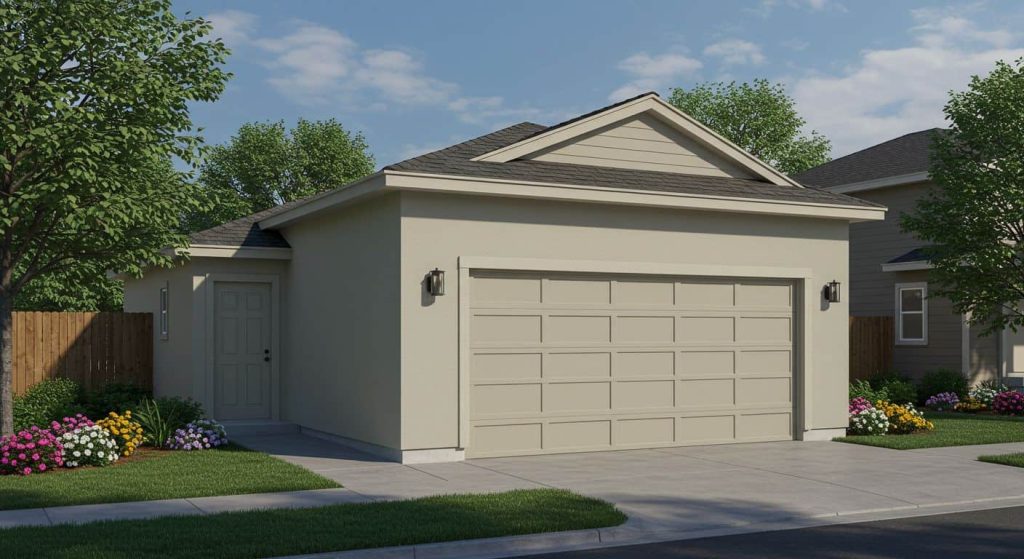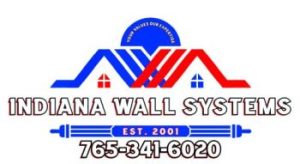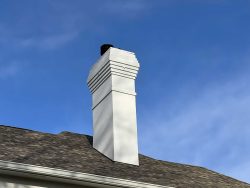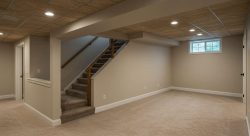Upgrade Your Garage Into a Stylish, Energy-Efficient Living Space
Is your garage just a storage space? It could be so much more. Many homeowners are turning garages into extra living areas. EIFS, or Exterior Insulation and Finish System, can help with this change.
This blog will show you how EIFS makes garage conversions easier and better. Ready to learn about creating new space in your home?
Key Takeaways
- EIFS wraps garages in insulation, cutting energy bills by $3,000 to $5,500 compared to other methods.
- Garage conversions with EIFS cost about $12,000 on average, including materials and labor.
- EIFS offers design flexibility with many colors, textures, and finishes to match your home’s style.
- Proper sealing and flashing are vital to prevent moisture damage in EIFS garage conversions.
- Adding skylights to EIFS garage conversions brings in natural light and can create stunning visual effects with layered tray ceilings.
What is EIFS (Exterior Insulation and Finish System)?
EIFS is a modern wall system that adds insulation and a stylish finish to buildings. It uses foam boards, a base coat, and a top coat to create a sleek, energy-saving exterior.
Overview of EIFS
EIFS stands for Exterior Insulation and Finish System. It’s a popular way to cover and insulate buildings. This system uses layers of materials to create a smooth, attractive outer surface.
The layers include insulation boards, a base coat, mesh, and a finish coat. Each part plays a key role in making buildings look good and work well.
EIFS is like a cozy sweater for your home – it keeps you warm and looks great too!
EIFS offers many perks for homeowners. It helps save energy by keeping heat in during winter and out during summer. The system also protects against moisture, which can cause mold and rot.
Plus, it’s easy to shape into different styles, giving homes a unique look. Let’s explore why EIFS is a smart choice for garage conversions.
Benefits of EIFS in construction
EIFS offers many perks for building projects. It acts as a shield, keeping homes cozy and cutting energy bills. This system wraps buildings in a snug blanket of insulation, stopping heat from escaping in winter and entering in summer.
Homeowners can see big savings on their power costs over time.
Beyond saving money, EIFS makes homes look great. It comes in countless colors and textures, letting owners pick the perfect look for their house. The smooth finish resists cracks and chips, staying fresh for years with little upkeep.
Plus, EIFS is tough against rain and wind, protecting homes from weather damage. For those wanting a stylish, energy-smart home, EIFS checks all the boxes.
EIFS vs. Traditional Building Materials: A Comparison
Building on the benefits of EIFS in construction, let’s compare EIFS to traditional building materials. This comparison will help you understand why EIFS stands out for garage conversions.
| Feature | EIFS | Traditional Materials |
| Energy Efficiency | High – Continuous insulation layer | Varies – Often lower due to thermal bridging |
| Installation Cost | Lower – Faster to install | Higher – More labor-intensive |
| Maintenance | Low – Resistant to cracks and chips | Higher – May need frequent repairs |
| Design Flexibility | High – Many finishes and textures available | Limited – Depends on material used |
| Weight | Light – Less stress on structure | Heavy – May require additional support |
| Weather Resistance | Excellent – Resists moisture and temperature changes | Varies – Some materials prone to weather damage |
EIFS offers clear advantages for garage conversions. It’s more energy-efficient and cost-effective than brick or wood. The system’s design flexibility allows for a smooth exterior finish. This can boost your property value and give a better return on investment. EIFS also needs less upkeep, saving you time and money in the long run.
Why Use EIFS for Garage Conversions?

EIFS offers a smart way to turn your garage into extra living space. It gives you better insulation, more design options, and protection from weather – all in one system.
Enhanced insulation and energy efficiency
EIFS offers top-notch insulation for garage conversions. It wraps your space in a cozy blanket, keeping heat in during winter and out in summer. This means less work for your heating and cooling systems, which saves you money on energy bills.
The system’s design cuts down on air leaks and thermal bridges, making your new room comfy year-round.
Energy costs can drop big time with EIFS. The system adds a thick layer of insulation to your walls, boosting their R-value. This extra padding helps maintain steady temps inside, no matter what’s happening outside.
Plus, EIFS works well with other energy-saving features like good windows and doors. Together, they create a tight seal against the elements, making your converted garage a true extension of your home.
Aesthetic flexibility and modern design options
EIFS offers a wide range of design choices for garage conversions. You can pick from many colors, textures, and finishes to match your home’s style. The system allows for custom shapes and details, like arches or decorative trim.
This flexibility lets you create a unique look that stands out in your neighborhood.
Modern design options with EIFS include sleek, smooth surfaces for a contemporary feel. You can also add faux stone or brick patterns without the weight of real masonry. EIFS even works well with layered tray ceilings or faux beams to create eye-catching indoor spaces.
For a bold touch, consider replacing old garage doors with stylish Belgian-style steel and glass options.
Weather resistance and durability
EIFS offers top-notch weather protection for garage conversions. Its layers create a shield against rain, wind, and harsh sun. This tough exterior keeps your new living space dry and cozy.
EIFS also stands up to time, lasting for decades with little upkeep. It won’t rot, warp, or crack like some other materials.
Your EIFS-clad garage will stay strong through many seasons. Its durability means fewer repairs and lower costs over time. Plus, EIFS resists fading, so your home’s look stays fresh for years.
Next, let’s explore how to plan your garage makeover with EIFS.
Maximizing Energy Savings with EIFS Insulated Facade
EIFS insulated facades can slash energy bills for homeowners. This system wraps your garage in a cozy blanket of insulation. It stops heat from escaping in winter and keeps cool air inside during summer.
The result? Lower heating and cooling costs all year round.
Proper installation is key to getting the most savings. A pro should put in the rigid boards and seal all gaps. They’ll also add a vapor barrier to block moisture. With EIFS, you could save $3,000 to $5,500 on insulation costs compared to other methods.
Plus, you’ll see long-term savings on your energy bills for years to come.
Planning Your Garage Conversion with EIFS
Planning a garage conversion with EIFS needs careful thought. You must check local rules and your budget before starting.
Assessing structural integrity
Checking your garage’s strength is key before turning it into a living space. A pro should look at the walls, floor, and roof to make sure they can handle the change. They’ll check for cracks, water damage, and weak spots.
This step costs $1,000 to $10,000, depending on what needs fixing.
You must pass inspections for any structural work done. This keeps your new space safe and legal. The inspector will look at things like the foundation, framing, and load-bearing walls.
Indiana Wall Systems will make sure everything meets local building codes. Next, we’ll talk about zoning and building code rules you need to know.
Evaluating zoning and building code requirements
After checking the garage’s structure, you must look at local rules. Zoning laws and building codes matter a lot. They say what you can do with your garage. Some areas don’t allow living spaces in garages.
Others have strict rules about it.
You need to get permits for your project. This includes work on plumbing, wiring, and heating. The city will check if your plans follow the rules. They’ll make sure the space is safe to live in.
Getting these permits takes time, but it’s key to a legal conversion.
Budget considerations for EIFS installation
Moving from zoning rules to budget planning, let’s talk money. EIFS installation costs can vary. Labor makes up a big chunk – between $5,000 and $15,000. The total bill for turning your garage into a living space averages $12,000.
This includes materials and work.
Planning ahead helps avoid surprises. Get quotes from several pros. Ask about extras like prep work or special finishes. Don’t forget permits and inspections in your budget. While EIFS may cost more upfront, it can save you cash on energy bills over time.
Think long-term when crunching numbers for your project.
Key Features of EIFS for Garage Conversions
EIFS offers key features that make garage conversions a breeze. These features boost comfort and energy savings in your new living space.
Thermal performance and reduced thermal bridging
EIFS boosts thermal performance in garage conversions. It wraps the building in a blanket of insulation, cutting heat loss through walls. This system stops thermal bridging, where heat escapes through studs or framing.
The result? A cozier space that costs less to heat and cool.
Homeowners gain big from EIFS’s thermal perks. It keeps indoor temps steady year-round. Energy bills drop as HVAC systems work less. Plus, the extra insulation muffles outside noise.
For garage makeovers, EIFS creates a comfy room that feels like part of the main house.
Moisture resistance and vapor barrier integration
EIFS systems offer great moisture protection for garage conversions. They use special coatings and barriers to keep water out. A vapor barrier stops moisture from getting inside the walls.
This helps prevent mold and rot. The system also lets any trapped moisture escape. This keeps the inside of your new living space dry and comfy.
Proper installation is key for moisture control. Experts use flashing around windows and doors. They also add drainage planes behind the EIFS. These features direct water away from the walls.
Good moisture management protects your investment for years to come. It also helps avoid costly repairs down the road.
Soundproofing benefits
EIFS garage conversions offer great soundproofing perks. The thick layers block outside noise, creating a quiet space inside. This makes the new room perfect for a home office or bedroom.
You’ll enjoy peace and privacy, away from street sounds or noisy neighbors.
The system also keeps noise from escaping. You can play music or watch TV without bothering others in the house. This freedom lets you use the space how you want, any time of day. The sound barrier works both ways, giving you a truly separate area in your home.
Steps to Retrofit a Garage with EIFS
Retrofitting a garage with EIFS involves key steps like prepping the exterior, adding insulation boards, and applying base and finish coats. Want to learn more about this process? Keep reading!
Preparing the garage exterior
Preparing your garage exterior is key for a smooth EIFS installation. Start by cleaning the walls. Remove dirt, grime, and loose paint. Fix any cracks or holes in the surface. Make sure the walls are dry and even.
This prep work helps the EIFS stick better and last longer.
Next, add a water barrier to the walls. This stops moisture from getting in. Then, put up foam boards for insulation. Secure them with glue or screws. Cover the boards with mesh for strength.
Now your garage is ready for the EIFS base coat and finish. Good prep leads to a great-looking, energy-saving space.
Installing rigid insulation boards
Rigid insulation boards form the core of EIFS for garage conversions. These boards, made of expanded polystyrene, offer great insulation value. Pros attach them to the garage’s outer walls with special glue or fasteners.
The boards come in different thicknesses, usually 1 to 4 inches. Thicker boards give better insulation but cost more.
Proper installation is key for the best results. Boards must fit snugly against each other with no gaps. Pros seal all joints and edges to stop air and moisture from getting in. This step helps create a solid barrier against heat loss and dampness.
Good installation leads to lower energy bills and a cozier living space.
Applying base and finish coats
Applying base and finish coats is a key step in EIFS installation. First, workers spread a base coat over the insulation boards. They use a trowel to make it smooth and even. Then, they embed a mesh into the wet base coat for strength.
After the base dries, they add the finish coat. This final layer gives the wall its color and texture. Homeowners can pick from many finish options to match their style. The whole process takes skill and care to get right.
Ensuring proper sealing and flashing
After applying base and finish coats, proper sealing and flashing are vital. These steps keep water out and protect your new EIFS garage conversion. Careful sealing around windows, doors, and other openings stops leaks.
Good flashing directs water away from the building. This prevents moisture damage and mold growth.
Pros use special sealants and flashing methods for EIFS. They seal all joints and edges with flexible caulk. Metal flashing goes above windows and doors. It also covers other spots where water might get in.
Doing this right makes your EIFS last longer and work better. It’s key to passing inspections too.
Design Ideas for EIFS Garage Conversions
EIFS garage conversions open up a world of design options. You can turn your old garage into a cozy bedroom, a sleek home office, or even a modern living room.
Creating a cozy bedroom
A cozy bedroom in your garage conversion starts with good insulation. EIFS helps keep the space warm in winter and cool in summer. It also blocks outside noise, making your new room quiet and peaceful.
You can add soft lighting and plush carpets for extra comfort. Don’t forget to include a reading nook or meditation corner for relaxation.
Your new bedroom needs the right layout too. Place the bed away from windows to avoid drafts. Use light colors on walls to make the space feel bigger. Add storage to keep clutter at bay.
This creates a calm, restful area perfect for sleep. Next, let’s look at setting up a home office or studio in your converted garage.
Setting up a home office or studio
A garage conversion can make a great home office or studio. Pick a quiet corner for your desk and add good lighting. Smart tech can boost Wi-Fi signals, keeping you connected. Use EIFS to insulate walls and reduce outside noise.
This creates a comfy space to work or create in. Paint the walls a calm color and add storage to keep things tidy.
Your new office needs the right tech setup too. Install plenty of outlets for your devices. Add a small fridge or coffee maker for breaks. Good chairs and desks help you work well.
With some planning, your garage can become a perfect spot to get things done. Next, let’s look at how to design a modern living room in your converted garage.
Designing a modern living room or entertainment space
From home office to living room, your garage can become a cozy hangout spot. Picture a sleek space with clean lines and comfy seating. Add an electric fireplace with a faux mantel for warmth and style.
Create a sunken conversation pit with a subfloor perimeter for a unique touch. This design makes the most of your sq ft while boosting your home’s value.
EIFS cladding helps make this modern space energy-efficient and quiet. Its smooth finish looks great and needs little upkeep. You can paint it any color to match your style. With EIFS, you’ll have a durable, weather-resistant room that’s perfect for movie nights or game days with friends.
Incorporating a kitchenette or wet bar
A modern living room can transform into a full entertainment space with a kitchenette or wet bar. These additions boost the room’s function and appeal. A small kitchenette fits well in a corner, with a fridge, hot plate, and microwave.
This setup lets guests grab snacks or drinks without going to the main kitchen. For those who love to host, a wet bar is perfect. It can have a draft system for beer and space for mixing cocktails.
Both options make the room more useful and fun for gatherings.
Enhancing Comfort in Your Converted Garage
A cozy garage conversion needs more than just walls and a roof. Smart HVAC systems and energy-efficient windows can turn your new space into a year-round haven. Natural light from skylights can brighten the room and cut down on energy costs.
Adding HVAC systems for heating and cooling
HVAC systems are key for comfort in your converted garage. These units keep the space warm in winter and cool in summer. You’ll need a pro to install them. They’ll check your home’s power and ductwork.
The right size system matters too. It should fit the room’s square footage. Good HVAC also helps with air quality. It filters out dust and pollen.
Costs vary based on the system you pick. Central air is pricey but works well. Mini-splits cost less and are easier to put in. They don’t need ducts. Both types can save energy if they’re new models.
Look for ones with high SEER ratings. These use less power and can cut your bills. Don’t forget about permits – most areas require them for HVAC work.
Installing energy-efficient windows and doors
Energy-efficient windows and doors make a big difference in garage conversions. They keep the space comfy and cut energy bills. New double-pane or triple-pane windows block heat and cold better than old single-pane ones.
Look for low-E coatings and argon gas fills for extra insulation. Doors with tight seals and good insulation also help a lot.
Pick windows and doors with ENERGY STAR labels to save the most energy. These meet strict rules set by the U.S. government. Steel and fiberglass doors often work best for garages. They’re strong and insulate well.
Don’t forget weatherstripping around all openings to stop drafts. Good installation is key – even great products won’t work right if put in poorly.
Maximizing natural light with skylights
After adding energy-efficient windows and doors, skylights offer another way to brighten your garage conversion. These roof windows let in lots of natural light, making your new space feel bigger and more open.
Skylights also help cut down on energy costs by reducing the need for artificial lighting during the day. You can choose from fixed or venting skylights to fit your needs. Fixed ones stay closed while venting skylights open to let in fresh air.
Some models even come with remote controls for easy operation.
Skylights do more than just light up a room. They can create stunning visual effects with layered tray ceilings. This design adds depth and drama to your converted garage. It draws the eye upward, making the space feel taller.
The extra light from above also helps showcase any special features or decor in your new living area. With the right placement, skylights can transform a basic garage into a bright, airy, and inviting space that you’ll love spending time in.
EIFS Home Weatherproofing Guide
EIFS offers great protection for your home. It acts like a shield against rain, wind, and harsh weather. This system keeps your house dry and comfy all year round. EIFS has many layers that work together to stop water from getting in.
It also helps save energy by keeping heat inside during winter and outside during summer.
To make sure your EIFS works well, you need to take care of it. Check for cracks or damage often. Clean the surface gently with soap and water. Fix any problems right away to avoid bigger issues later.
With proper care, EIFS can keep your home safe and cozy for many years.
Maintenance Tips for EIFS on Garage Conversions
Regular care keeps your EIFS-converted garage looking great and working well. Want to learn how to keep your new space in top shape? Read on for easy tips and tricks.
Regular inspections for cracks or damage
EIFS needs regular check-ups to stay in good shape. Look for cracks or damage often. This helps catch small issues before they grow big. Quick fixes can save you money in the long run.
Keep an eye out for any odd spots on your garage walls. If you see something strange, call a pro right away. They can fix the problem fast and keep your EIFS looking great.
Experts say to inspect your EIFS at least once a year. Spring is a good time to do this. The winter can be tough on walls, so check for any new problems. Don’t forget to look at the edges around windows and doors.
These spots can let water in if not sealed well. A little care now means less worry later. Your garage conversion will stay cozy and dry with proper EIFS upkeep.
Cleaning and repainting EIFS surfaces
Keeping EIFS surfaces clean and fresh is key to their long life. Regular cleaning stops mold and mildew from growing. This keeps your home looking good and lasting longer. Use the right cleaning products to avoid harm to the EIFS.
Soft brushes and mild soaps work best. Avoid power washing, as it can damage the surface.
Repainting EIFS gives your home a new look and extra protection. It guards against weather and keeps the surface strong. Choose paints made for EIFS to get the best results. Apply them with care, following the maker’s tips.
This helps your EIFS last many years. Next, let’s look at how to spot and fix cracks in your EIFS.
Preventing moisture infiltration
Moisture can sneak into your garage conversion and cause big problems. To stop this, you need good airflow and fans that remove damp air. Open windows help too. They let fresh air in and push out the moist stuff.
Keep an eye on your heating and cooling systems. Check them often to make sure they work right. This helps control moisture levels in your new space.
A humidity gauge is a smart tool to have. It tells you how much moisture is in the air. If it’s too high, take action fast. Use a dehumidifier or turn up the fans. These steps keep your walls dry and your air healthy.
With the right care, your garage can stay dry and comfy for years to come.
Costs and ROI of EIFS Garage Conversions
EIFS garage conversions can boost your home’s value. They offer energy savings and extra space, making them a smart investment.
Upfront installation costs
EIFS installation costs for garage conversions can vary. Homeowners should budget $7 to $15 per square foot for materials and labor. This price includes insulation boards, base coat, mesh, and finish coat.
Factors like garage size, wall condition, and design complexity affect the total cost. Permits and fees add $2,000 to $3,000 to the project.
Structural work is another key expense. Depending on the garage’s current state, this can range from $1,000 to $10,000. It may involve reinforcing walls, adding windows, or upgrading electrical systems.
While these costs seem high, EIFS offers long-term energy savings and increased home value. Many find the investment worthwhile for creating extra living space.
Long-term energy savings
EIFS garage conversions offer big energy savings over time. The system’s thick insulation keeps heat in during winter and out in summer. This cuts heating and cooling costs by up to 30% each year.
Homeowners see lower energy bills right away, but the real payoff comes later. Over 10-20 years, these savings add up to thousands of dollars. The money saved often covers the initial cost of the EIFS install.
Beyond cash savings, EIFS helps the planet too. Less energy use means fewer carbon emissions from power plants. This eco-friendly choice aligns with green building trends. It can boost a home’s resale value, as buyers seek energy-efficient houses.
With rising energy prices, the long-term benefits of EIFS only grow larger.
Increased home resale value
EIFS garage conversions can boost your home’s resale value. Turning your garage into living space adds square footage, which often means a higher price tag. Buyers love extra rooms for offices, gyms, or guest areas.
This upgrade can give you a 60% to 80% return on investment when you sell.
Over time, the payoff can be huge. Let’s say you spend $100,000 on a garage conversion. If you rent out that space for 30 years, you could make $1.5 million. That’s 15 times what you put in! This shows how a smart garage makeover can really pay off in the long run.
Common Challenges and Solutions
Garage conversions can face tricky issues. Smart planning helps solve these problems. Proper drainage systems and fire safety measures are key to a successful project.
Managing condensation risks
Moisture buildup can be a big problem in garage conversions. It can lead to mold and damage walls. To stop this, you need good airflow and the right insulation. Put in vents to let damp air out.
Use materials that don’t trap water. Also, seal any gaps where cold air might get in. This helps keep the inside dry and comfy.
A dehumidifier can also help control moisture. It pulls water from the air, making the space less damp. Check often for signs of water or mold. Fix any leaks fast. With these steps, you can keep your new room dry and safe.
Good moisture control makes your garage space last longer and feels better to live in.
Ensuring proper drainage systems
Proper drainage systems are key for EIFS garage conversions. Water must flow away from the building to avoid damage. Good drainage starts with sloping the ground around the garage.
This helps water move away from the walls. Gutters and downspouts also play a big role. They catch rain and direct it away from the structure.
Inside the EIFS system, a water-resistant barrier is crucial. This layer stops moisture from getting into the wall. Flashing around windows and doors adds extra protection. Regular checks of these systems keep your converted garage dry and cozy.
A pro can spot issues before they become big problems.
Addressing potential fire code compliance
Fire safety is key in garage conversions. EIFS must meet local fire codes. This often means using fire-resistant materials and proper insulation. Builders need to install smoke alarms and ensure easy exits.
They may also need to add fire-rated walls or doors.
Homeowners should work with pros who know fire codes. These experts can design safe EIFS systems for garage conversions. They’ll make sure the new space meets all safety rules. Next, let’s look at the wrap-up of our EIFS garage conversion guide.
Conclusion
EIFS offers a smart way to turn your garage into extra living space. It keeps your new room comfy and saves energy. With EIFS, you can make your garage look great and match your home’s style.
This system is tough and lasts a long time, so you won’t need to fix it often. Using EIFS for your garage makeover can boost your home’s value and give you more room to enjoy.
FAQs
Is EIFS a good choice for garage conversions?
EIFS, or synthetic stucco, is great for garage conversions. It’s light, only 8-12 pounds per square foot. This means less stress on your garage slab. EIFS also gives good sound and thermal insulation. It helps create a cozy living space.
How does EIFS compare to traditional stucco for exterior walls?
EIFS beats traditional cement plaster stucco in many ways. It’s easier to install and needs less labor. EIFS offers better insulation and is more flexible. You can create special shapes and details with EIFS. It rarely needs repairs, unlike regular stucco that can crack.
What’s the cost difference between EIFS and other cladding options?
EIFS often costs less than brick or stone. The exact price depends on your project. But EIFS can save you money on labor costs. It also cuts down on energy bills due to its insulation. These savings can offset the upfront costs over time.
Do I need a building permit for an EIFS garage conversion?
Yes, you’ll need a building permit. This is true for any big change to your home. Check local zoning rules too. They may have rules about turning garages into living spaces. A pro can help you navigate these steps.
How long does an EIFS installation take for a garage conversion?
An EIFS install is usually quick. It can take 1-2 weeks for a typical garage. This includes prep work and finishing touches. Weather can affect the timeline. But EIFS is often faster than traditional stucco, which needs three coats and drying time.
Is special maintenance needed for EIFS on a converted garage?
EIFS is low-maintenance. It doesn’t need painting like wood siding. But you should check for cracks or damage yearly. Clean it gently with soap and water. Make sure water drains away from the walls. Proper installation with good flashing is key to prevent issues.





